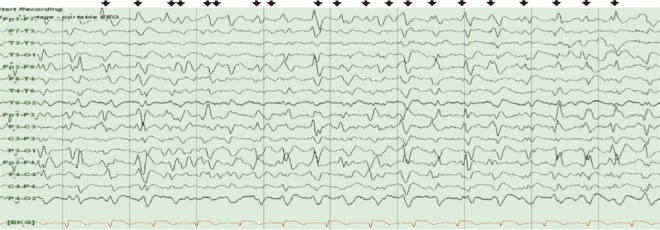An Overlooked Cause of Impaired Consciousness in a Hemodialysis Patient
Article information
A 68-year-old diabetic woman was admitted to our hospital for pneumonia. Her medical history included hemodialysis for the past 3 years, but no history of epilepsy or convulsive disorder. Her pneumonia was treated with intravenous cefepime, with the dose adjusted to her impaired renal function. On the 7th day of cefepime therapy, she suddenly became confused, and rapidly became stuporous, but without motor seizures. Neurologically, there was no neck rigidity or any focal neurological deficit, except lip smacking. Brain magnetic resonance imaging showed small vessel disease. Electroencephalography (EEG) indicated generalized bursts of repetitive sharp-waves and spike-and-wave complexes (arrows), suggesting non-convulsive status epilepticus (NCSE) (Fig. 1). The intravenous cefepime was discontinued, and a combination of valproic acid and lorazepam was given intravenously. The EEG findings and her mental state improved gradually following the anticonvulsant treatment and she eventually became fully alert and oriented (Fig. 2).

The electroencephalogram showed generalized bursts of repetitive sharp-waves and spike-and-wave complexes, suggesting non-convulsive status epilepticus.
Impaired consciousness in uremic patients has many different etiologies, including metabolic encephalopathies, hypertensive crisis, infection, drug toxicity, ands NCSE. NCSE is a frequently underdiagnosed, but treatable cause of acute confusion or impaired consciousness and may occur during dialysis. Typically, the EEG in NCSE shows generalized spike-and-wave complexes at 3 Hz or repetitive generalized or focal spikes, sharp-waves, and spike-and-wave complexes at > 4/sec. Events that can precipitate NCSE include alcohol, drug withdrawal, infection, hypoxia, cerebrovascular accident, menstruation, cyclosporine A therapy, malignancy, and antibiotic neurotoxicity. Antibiotics have been reported to cause seizures in patients with decreased renal function, including penicillins, cephalosporins, imipenem/cilastatin, and quinolones.
This case demonstrates that NCSE should be included in the differential diagnosis of impaired consciousness in uremic patients.
Acknowledgments
This paper was supported by the Fund of Chonbuk National University Hospital Research Institute of Clinical Medicine.
Notes
No potential conflict of interest relevant to this article is reported.
